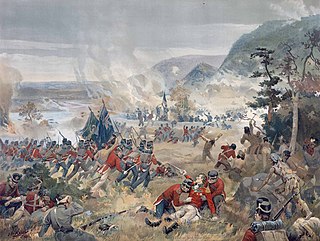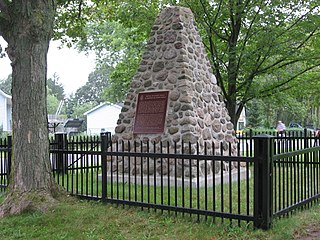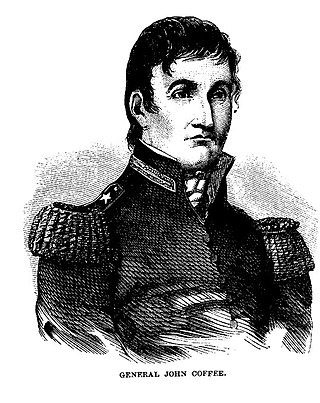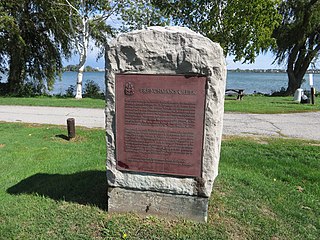
The Battle of the Thames, also known as the Battle of Moraviantown, was an American victory in the War of 1812 against Tecumseh's Confederacy and their British allies. It took place on October 5, 1813, in Upper Canada, near Chatham. The British lost control of Southwestern Ontario as a result of the battle; Tecumseh was killed, and his confederacy largely fell apart.

The Battle of Queenston Heights was the first major battle in the War of 1812. Resulting in a British victory, it took place on 13 October 1812 near Queenston, Upper Canada.

The Battle of Lundy's Lane, also known as the Battle of Niagara, was a battle fought on 25 July 1814, during the War of 1812, between an invading American army and a British and Canadian army near present-day Niagara Falls, Ontario. It was one of the bloodiest battles of the war, and one of the deadliest battles fought in Canada, with approximately 1,720 casualties including 258 killed.

The Battle of Chippawa, also known as the Battle of Chippewa, was a victory for the United States Army in the War of 1812, during its invasion on July 5, 1814, of the British Empire's colony of Upper Canada along the Niagara River. This battle and the subsequent Battle of Lundy's Lane demonstrated that trained American troops could hold their own against British regulars. The battlefield is preserved as a National Historic Site of Canada.

The siege of Fort Erie, also known as the Battle of Erie, from 4 August to 21 September 1814, was one of the last engagements of the War of 1812, between British and American forces. It took place during the Niagara campaign, and the Americans successfully defended Fort Erie against a British army. During the siege, the British suffered high casualties in a failed storming attempt; they also suffered casualties from sickness and exposure in their rough encampments. Unaware that the British were about to abandon the siege, the American garrison launched a sortie to destroy the British siege batteries, during which both sides again suffered high losses.

The Battle of North Point was fought on September 12, 1814, between General John Stricker's Maryland Militia and a British force led by Major General Robert Ross. Although the Americans retreated, they were able to do so in good order having inflicted significant casualties on the British, killing one of the commanders of the invading force, significantly demoralizing the troops under his command and leaving some of his units lost among woods and swampy creeks, with others in confusion. This combination prompted British colonel Arthur Brooke to delay his advance against Baltimore, buying valuable time to properly prepare for the defense of the city as Stricker retreated back to the main defenses to bolster the existing force. The engagement was a part of the larger Battle of Baltimore, an American victory in the War of 1812.


The Battle of Ogdensburg was a battle of the War of 1812. The British gained a victory over the Americans and captured the village of Ogdensburg, New York. Although small in scale, it removed the American threat to British supply lines for the remainder of the war.

John R. Coffee was an American planter of Irish descent, and a state militia brigadier general in Tennessee. He commanded troops under General Andrew Jackson during the Creek Wars (1813–14) and during the Battle of New Orleans in the War of 1812.

The Capture of Fort Niagara took place late in 1813, during the War of 1812 between the United Kingdom and the United States. The American garrison was taken by surprise, and the fort was captured in a night assault by a select force of British regular infantry.

The Battle of Fort Ontario was a partially successful British raid on Fort Ontario and the village of Oswego, New York on May 6, 1814 during the War of 1812.
Benjamin Forsyth was an American officer of rifle troops in the War of 1812 between Britain and the United States. Born in North Carolina, Forsyth joined the United States Army in 1800 as an officer and was a captain of the Regiment of Riflemen at the outbreak of war in 1812. He led raids into Upper Canada along the Saint Lawrence River in 1812–13 before transferring south and taking part in the battles of York and Fort George. Promoted to brevet lieutenant colonel, he held a command along Lake Champlain. Forsyth was killed in June 1814 at Odelltown, Lower Canada.

The following is a synopsis of the land campaigns of the War of 1812.

Scajaquada Creek is a stream in Erie County, New York, United States. The name is derived from Philip Kenjockety, a Native American described as the oldest resident of the region upon his death in 1808.

The Battle of Buffalo took place during the War of 1812 on December 30, 1813, in the State of New York, near the Niagara River. The British forces drove off the American defenders and destroyed many buildings and ships. The operation was retaliation for American troops burning the Canadian village of Newark.
The Canadian Volunteers was a unit composed of pro-United States citizens or inhabitants of Upper Canada which fought for the United States of America during the Anglo-American War of 1812.

The Regiment of Riflemen was a unit of the U.S. Army in the early nineteenth century. Unlike the regular US line infantry units with muskets and bright blue and white uniforms, this regiment was focused on specialist light infantry tactics, and were accordingly issued rifles and dark green and black uniforms to take better advantage of cover. This was the first U.S. rifleman formation since the end of the American Revolutionary War 25 years earlier.
Where can you find troops more efficient than Morgan's riflemen of the Revolution or Forsyth's riflemen of the last war with Great Britain?
Under the designation Regiment of Light Dragoons existed two different units of the U.S. Army in the late eighteenth and early nineteenth centuries, respectively. A first unit of its name was short lived, established just prior the Quasi-War with France, in 1798 and discharged in 1800.















